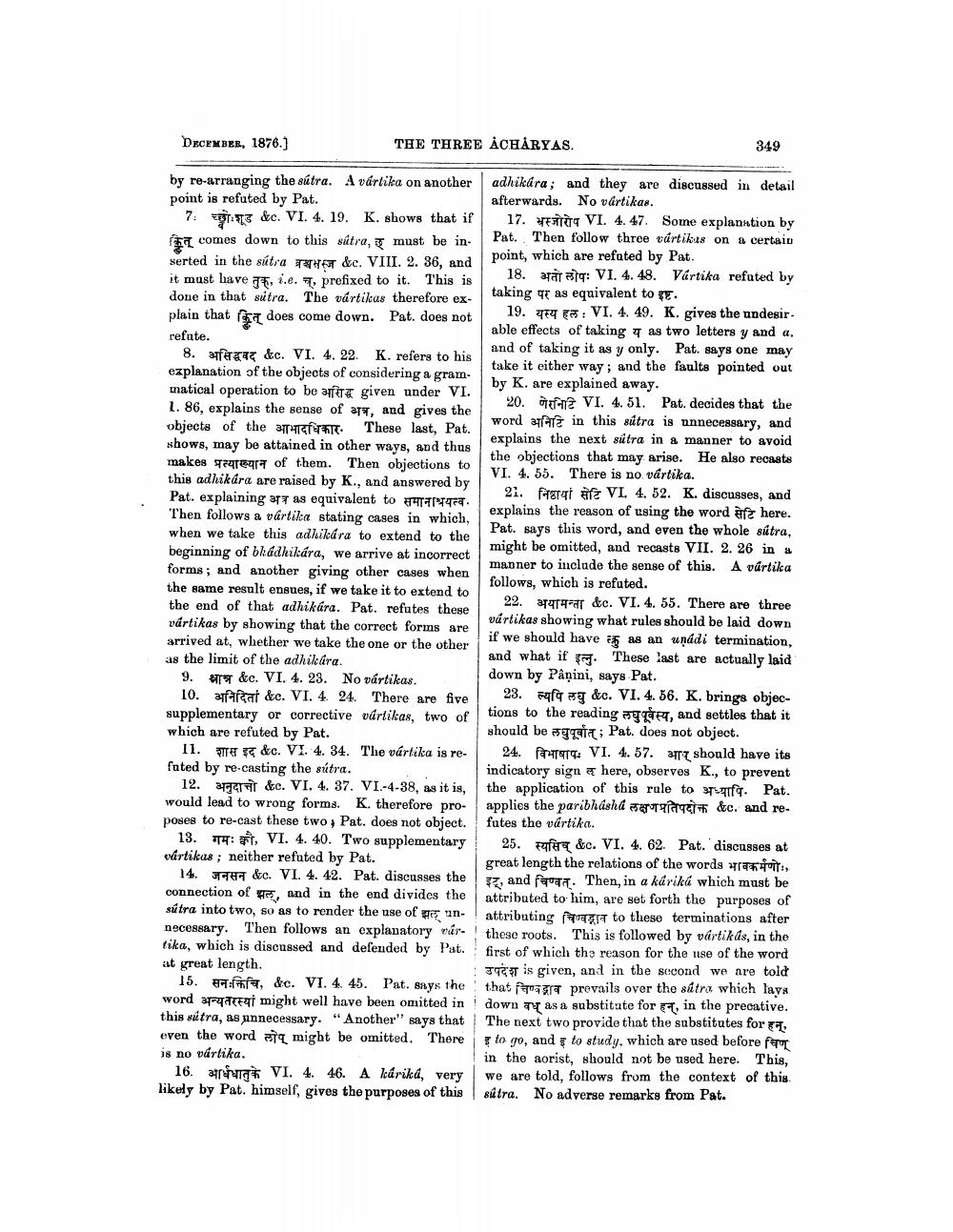________________
DECEMBER, 1876.)
THE THREE ACHÅRYAS.
349
by re-arranging the sútra. A vártika on another point is refuted by Pat.
7: 1:3 &c. VI. 4. 19. K. shows that if on comes down to this sútra, y must be in serted in the sútra THT &c. VIII. 2. 36, and it must have 76, 1.e. 77, prefixed to it. This is done in that sutra. The vártikas therefore explain that en does come down. Pat. does not refute.
8. afcat &c. VI. 4. 22. K. refers to his explanation of the objects of considering a gram. matical operation to be at given under VI. 1. 86, explains the sense of art, and gives the objects of the frame. These last, Pat. shows, may be attained in other ways, and thus makes area of them. Then objections to this adhikára are raised by K., and answered by Pat. explaining अz as equivalent to समानाश्रयत्व. Then follows a vártika stating cases in which, when we take this adhikúra to extend to the beginning of bhadhikára, we arrive at incorrect forms; and another giving other cases when the same result ensues, if we take it to extend to the end of that adhikára. Pat. refutes these vártikas by showing that the correct forms are arrived at, whether we take the one or the other as the limit of the adhikara.
9. &c. VI. 4. 23. No vártikas.
10. aftreat &c. VI. 4. 24. There are five supplementary or corrective vürtikas, two of which are refuted by Pat.
11. &c. VI. 4. 34. The vártika is refuted by re-casting the sútra.
12. Tri &c. VI. 4. 37. VI.-4-38, as it is, would lead to wrong forms. K. therefore pro- poses to re-cast these two , Pat. does not object.
13. TH . VI. 4. 40. Two supplementary 1 sártikas ; neither refuted by Pat.
14. TTH &c. VI. 4. 42. Pat. discusses the connection of fres, and in the end divides the sútra into two, so as to render the use of P un- necessary. Then follows an explanatory vár- tika, which is discussed and defended by Pat. at great length.
15. , &c. VI. 4. 45. Pat, says the word aparat might well have been omitted in this sátra, as unnecessary. "Another" says that even the word 9 might be omitted. There is no várlika.
16. augħ VI. 4. 46. Akárika, very likely by Pat. himself, gives the purposes of this
adhikara; and they are discussed in detail afterwards. No vártikas.
17. EATOTT VI. 4. 47. Some explanation by Pat. Then follow three vártikus on a certain point, which are refuted by Pat.
18. Tatata: VI. 4. 48. Vartika refuted by taking or as equivalent to st.
19. 4 : VI. 4. 49. K. gives the undesir. able effects of taking y as two letters y and a, and of taking it as y only. Pat, says one may take it either way; and the faults pointed out by K. are explained away.
20. One VI. 4. 51. Pat. decides that the word apart in this sútra is unnecessary, and explains the next sútra in a manner to avoid the objections that may arise. He also recasts VI. 4. 55. There is no vārtika.
21. fragt HC VL 4. 52. K. discusses, and explains the reason of using the word art here. Pat, says this word, and even the whole sútra, might be omitted, and recasts VII. 2. 26 in a manner to include the sense of this. A vártika follows, which is refuted.
22.ar &c. VI. 4. 55. There are three vártikas showing what rules should be laid down if we should have 5 as an uņádi termination, and what if . These 'ast are actually laid down by Påņini, says Pat.
23. fa ag &c. VI. 4. 56. K. brings objections to the reading , and settles that it should be greit; Pat. does not object.
24. P C: VI. 4. 57. Brry should have its indicatory sign & here, observes K., to prevent the application of this rule to starfa. Pat. applies the paribhasha T TCIT &c. and refutes the vártika.
25. &c. VI. 4. 62. Pat. discusses at great length the relations of the words भावकर्मणो:,
7, and an. Then, in a kárika which must be attributed to him, are set forth the purposes of attributing on to these terminations after these roots. This is followed by vártikas, in the first of which the reason for the use of the word TTT is given, and in the second we are told that can prevails over the sátra which lays down a as a substitute for , in the precative. the next two provide that the substitutes for TT,
to go, and to study, which are used before from in the aorist, should not be used here. This, we are told, follows from the context of this. sútra. No adverse remarks from Pat.




